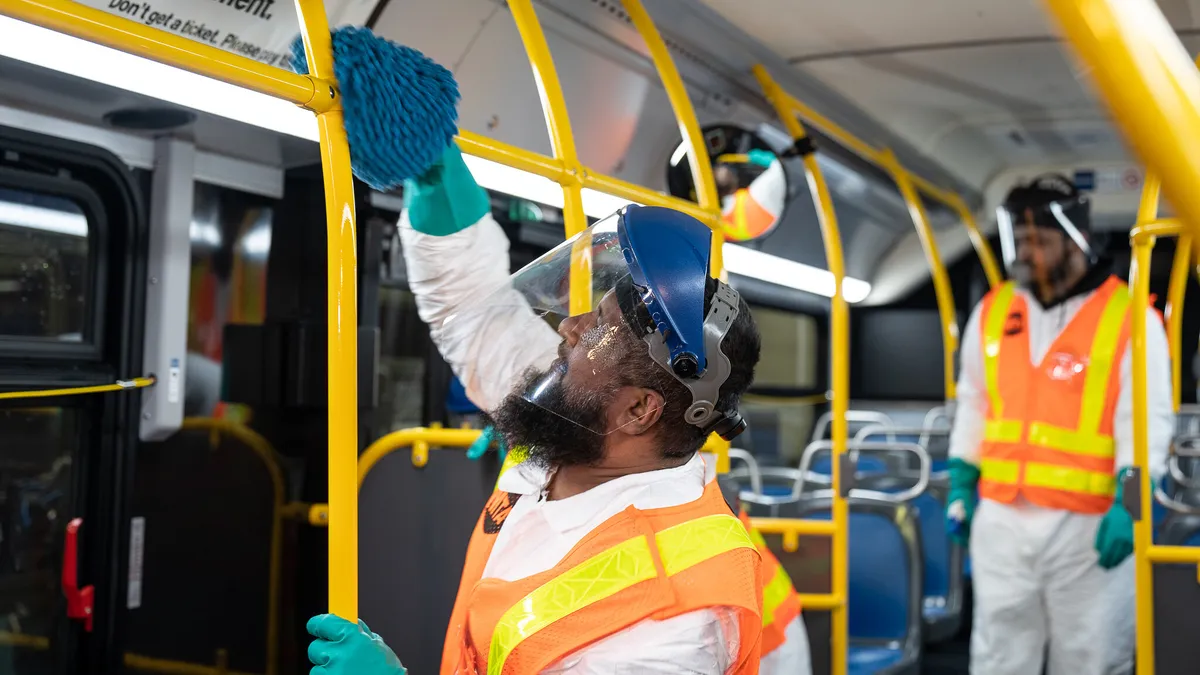Dive Brief:
- The Centers for Disease Control and Prevention (CDC) released this week a 60-page document of guidance to support a number of industries and critical infrastructure workers in gradually scaling up operations, as the nation moves toward the recovery stage of the new coronavirus (COVID-19) pandemic.
- In a section titled, "Interim Guidance for Mass Transit Administrators," the CDC outlines three main steps for transit administrators to take to eventually resume full service:
- Restricting ridership to essential critical infrastructure workers in areas needing significant mitigation
- Maintaining social distancing between transit riders and employees as much as possible
- Encouraging social distancing as much as possible
- In execution of these steps, the CDC advises the following safety actions:
- Promoting healthy hygiene practices
- Intensifying cleaning, disinfection and ventilation
- Training employees to maintain social distancing
- Conducting health checks on employees
- Planning for when an employee becomes sick
- Maintaining healthy operations
- Coordinating with health officials to adjust operations as needed
Dive Insight:
While much of the CDC's guidance may appear obvious to transit administrators, the recommendations are critical in ensuring efforts to reopen the economy are not squashed by an uptick in COVID-19 cases. The guidelines also offer creative suggestions — such as using ventilation systems to increase the circulation of outdoor air, or installing partitions on transit vehicles — that could serve as tangible solutions for agencies seeking a refresh of mitigation strategies.
In protecting transit staff, the CDC recognized not all mass transit employees face the same challenges or have the same needs, and included customized operator guidance for four groups of workers: bus transit operators; rail transit operators; transit maintenance workers and transit station workers.
The protection of mass transit workers is growing increasingly important as the pandemic persists. In New York's Metropolitan Transportation Authority (MTA) alone, the authority has lost more than 120 workers to the virus, a number that has climbed steadily over the last two months. Agencies in Philadelphia, Chicago, Atlanta, Detroit and many others have also reported employee deaths.
"The work that we have always done has been really important, but in the past few weeks it’s literally become a matter of life and death," said Swiftly transit planner Jenn Golech in an April webinar.
Recovery will likely be a slow and drawn out journey for mass transit, especially as agencies face revenue losses that threaten their existence. On a press call hosted by the American Public Transportation Association (APTA) last week, MTA President of Construction and Development John Lieber said his agency is "going broke" in an effort to maintain transit operations for the people of New York.
The return to pre-coronavirus ridership levels will also be slow as many riders will likely hesitate to board a crowded train or bus, instead opting for a more secluded transportation option like a car. This projected trend may set the transit industry back as other industries resume "normalcy," yet leaders are confident that a consistent dedication to safe and rider-focused operations will likely draw those riders back in over time.
To keep up with all of our coverage on how the new coronavirus is impacting U.S. cities, visit our daily tracker.












